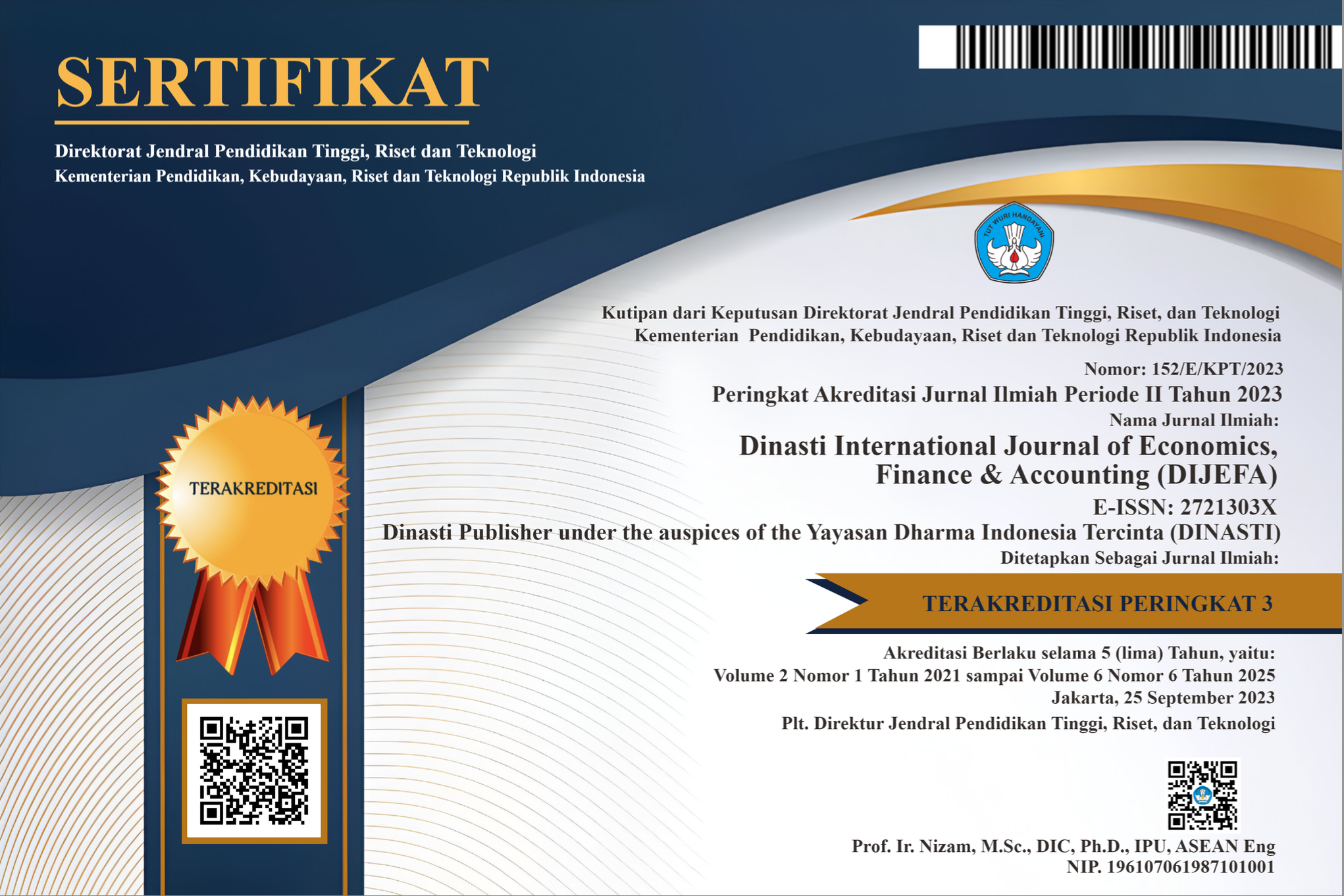Cryptocurrency And Financial Inclusion: Bridging The Gap In Emerging Countries
DOI:
https://doi.org/10.38035/dijefa.v5i2.2554Keywords:
Cryptocurrency, Cross-Border Payment, Emerging Countries, Opportunities, Financial SectorAbstract
The main purpose of this research is to determine the function of cryptocurrencies as a transactions medium in developing country and solve critical economic problems through the application of practical and ethical solutions from cryptocurrencies. The research objectives included examining the extent to which the adoption of cryptocurrency has disrupted traditional financial systems and affected economic development, as well as investigating the potential benefits and challenges of using cryptocurrency for emerging market. The results showed that cryptocurrency offers benefits such as reduced transaction costs, faster settlement times, and increased transparency in transactions. However, there are also challenges such as regulatory and legal hurdles, security concerns, and limited understanding of cryptocurrency. The study also highlights the factors that influence the adoption of cryptocurrency in international trade, including regulatory and legal frameworks, security concerns, awareness and understanding of cryptocurrency, transaction costs, and integration with existing systems. Overall, the study provides insights into the potential opportunities and challenges presented by cryptocurrency in global trade and commerce, and the implications for policymakers, businesses, and investors.
References
B. Esmaeilian, J. Sarkis, K. Lewis, and S. Behdad, “Blockchain for the future of Sustainable Supply Chain Management in industry 4.0,” Resources, Conservation and Recycling, vol. 163, p. 105064, 2020. doi:10.1016/j.resconrec.2020.105064
C. Stoll, L. Klaaßen, and U. Gallersdörfer, “The carbon footprint of Bitcoin,” Joule, vol. 3, no. 7, pp. 1647–1661, 2019. doi:10.1016/j.joule.2019.05.012
J. H. Chou, P. Agrawal, and J. Birt, “Accounting for crypto-assets: Stakeholders’ perceptions,” Studies in Economics and Finance, vol. 39, no. 3, pp. 471–489, 2022. doi:10.1108/sef-10-2021-0469
D. A. Zetzsche, R. P. Buckley, D. W. Arner, and M. van Ek, “Remaining regulatory challenges in digital finance and crypto-assets after mica,” SSRN Electronic Journal, 2023. doi:10.2139/ssrn.4487516
A. Y. Mafruhat, B. A. Rahmawan, and N. A. Robbani, “Dampak cryptocurrency TERHADAP Sistemmoneter: SebuahTinjauan Pustaka sistematis,” Bina Ekonomi, vol. 26, no. 2, pp. 97–106, 2022. doi:10.26593/be.v26i2.5840.97-106
B. Sak?z and A. H. Gencer, “Digital currencies, cryptocurrencies and Central Bank Digital Currencies,” International Conference on Eurasian Economies 2022, 2022. doi:10.36880/c14.02621
A. BenSaïda, “The linkage between Bitcoin and foreign exchanges in developed and emerging markets,” Financial Innovation, vol. 9, no. 1, 2023. doi:10.1186/s40854-023-00454-w
P. Benigno, L. Schilling, and H. Uhlig, “Cryptocurrencies, currency competition and the impossible trinity,” SSRN Electronic Journal, 2019. doi:10.2139/ssrn.3423326
R. Mi?kiewicz, K. Matan, and J. Karnowski, “The role of crypto trading in the economy, renewable energy consumption and ecological degradation,” Energies, vol. 15, no. 10, p. 3805, 2022. doi:10.3390/en15103805
Kim, H., Sefcik, J. S., & Bradway, C. (2017). Characteristics of qualitative descriptive studies: A systematic review. Research in Nursing & Health, 40(1), 23–42.
Doyle L, McCabe C, Keogh B, Brady A, McCann M. An overview of the qualitative descriptive design within nursing research. J Res Nurs. 2020 Aug;25(5):443-455. doi: 10.1177/1744987119880234. Epub 2019 Dec 18. PMID: 34394658; PMCID: PMC7932381.
Martins, F. S., Cunha, J. A. C. da, & Serra, F. A. R. (2018). Secondary Data in Research – Uses and Opportunities. Revista Ibero-Americana de Estratégia, 17(04), 01–04. Researchgate. https://doi.org/10.5585/ijsm.v17i4.2723
Demirgu?c?-Kunt A, Klapper L, Singer D, Ansar S, Hess J (2018) The Global Findex Database 2017: measuring financial inclusion and the fintech revolution. World Bank Group, Washington, DC.
Sahay R, Cihak M, N’Diaye PM, Barajas A, Mitra S, Kyobe A, Mooi YN, Yousefi SR (2015) Financial inclusion: can it meet multiple macroeconomic goals? IMF Staff Discussion Notes 15/17, International Monetary Fund. https://www. imf.org/external/pubs/ft/sdn/2015/sdn1517.pdf
Sarma M (2012) Index of financial inclusion—a measure of financial sector inclusiveness. Berlin Working Papers on Money, Finance, Trade and Development, 07/2012. https://finance-and-trade.htw-berlin.de/fileadmin/HTW/ Forschung/Money_Finance_Trade_Development/working_paper_series/wp_07_2012_Sarma_Index-of-Finan cial-Inclusion.pdf
Greenwald, Michael B. “How Digital Assets Will Impact Financial Inclusion and Energy Consumption.” Belfer Center for Science and International Affairs, August 10, 2021.
Ohnesorge, J. (2018). A Primer on Blockchain Technology and Its Potential for Financial Inclusion, Discussin Paper. doi:10.23661/dp2.2018
M. Lichtfous, V. Yadav, & V. Fratino (2018). Can Blockchain Accelerate Financial Inclusion Globally, Inside Magazine, 19. Retrieved from: https://theblockchaintest.com/uploads/resources/file-36385816098.pdf.
Downloads
Published
How to Cite
Issue
Section
License
Copyright (c) 2024 Antonius Ary Setyawan, Hugo Prasetyo Winotoatmojo, Natasha Kristi Puspa Ananda

This work is licensed under a Creative Commons Attribution 4.0 International License.
Authors who publish their manuscripts in this journal agree to the following conditions:
- The copyright on each article belongs to the author(s).
- The author acknowledges that the Dinasti International Journal of Economics, Finance & Accounting (DIJEFA) has the right to be the first to publish with a Creative Commons Attribution 4.0 International license (Attribution 4.0 International (CC BY 4.0).
- Authors can submit articles separately, arrange for the non-exclusive distribution of manuscripts that have been published in this journal into other versions (e.g., sent to the author's institutional repository, publication into books, etc.), by acknowledging that the manuscript has been published for the first time in the Dinasti International Journal of Economics, Finance & Accounting (DIJEFA).


























































